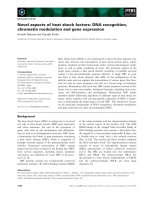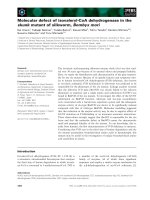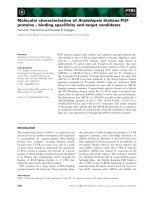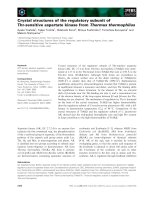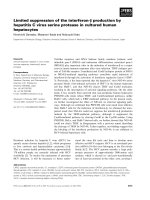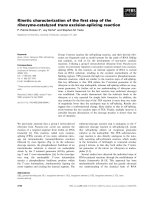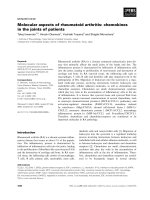Báo cáo khoa học: Cytochrome P460 of Nitrosomonas europaea Formation of the heme-lysine cross-link in a heterologous host and mutagenic conversion to a non-cross-linked cytochrome c ¢ pot
Bạn đang xem bản rút gọn của tài liệu. Xem và tải ngay bản đầy đủ của tài liệu tại đây (245.16 KB, 7 trang )
Cytochrome P460 of
Nitrosomonas europaea
Formation of the heme-lysine cross-link in a heterologous host and mutagenic
conversion to a non-cross-linked cytochrome
c
¢
David J. Bergmann
1
and Alan B. Hooper
2
1
Department of Biology, Black Hills State University, Spearfish, SD, USA;
2
Department of Biochemistry, Molecular Biology,
and Biophysics, University of Minnesota, MN, USA
The heme of cytochrome P460 of Nitrosomonas europaea,
which is covalently crosslinked to two cysteines of the
polypeptide as with all c-type cytochromes, has an additional
novel covalent crosslink to lysine 70 of the polypeptide
[Arciero, D.M. & Hooper, A.B. (1997) FEBS Lett. 410, 457–
460]. The protein can catalyze the oxidation of hydroxyl-
amine. The gene for this protein, cyp,wasexpressedin
Pseudomonas aeruginosa strain PAO lacI, resulting in for-
mation of a holo-cytochrome P460 which closely resembled
native cytochrome P460 purified from N. europaea in its
UV-visible spectroscopic, ligand binding and catalytic
properties. Mutant versions of cytochrome P460 of
N. europaea in which Lys70 70 was replaced by Arg, Ala, or
Tyr, retained ligand-binding ability but lost catalytic ability
and differed in optical spectra which, instead, closely
resembled those of cytochromes c¢. Tryptic fragments con-
taining the c-heme joined only by two thioether linkages
were observed by MALDI-TOF for the mutant cyto-
chromes P460 K70R and K70A but not in wild-type cyto-
chrome P460, consistent with the structural modification of
the c-heme only in the wild-type cytochrome. The present
observations support the hypothesized evolutionary
relationship between cytochromes P460 and cytochromes c¢
in N. europaea and M. capsulatus [Bergmann, D.J., Zahn,
J.A., & DiSpirito, A.A. (2000) Arch. Microbiol. 173, 29–34],
confirm the importance of a heme-crosslink to the spectro-
scopic properties and catalysis and suggest that the crosslink
might form auto-catalytically.
Keywords: cytochrome c¢; cytochrome P460; hydroxyl-
amine; nitric oxide, Nitrosomonas.
Cytochromes P460 are mono-heme cytochromes character-
ized by Soret absorption maxima at approximately 435, 460
and 450 nm in the ferric, ferrous and ferrous-CO forms,
respectively [1–4]. Although the protein catalyzes the
oxidation of hydroxylamine, its physiological role has not
been clearly elucidated.
Cytochrome P460 of Nitrosomonas is a homo-trimer [2,3]
or possibly -dimer [1] of 18 kDa subunits. Several unique
features of the optical spectra of cytochrome P460 are
shared by Ôheme-P460Õ, the active site heme of hydroxyl-
amine oxidoreductase (HAO) of N. europaea. HAO is a
homo-trimer of octa-heme subunits which catalyzes high
rates of dehydrogenation of hydroxylamine [5–8]. In addition
to two thioether linkages to cysteine residues, active site
hemes of cytochrome P460 or HAO have a third covalent
linkage from a heme to Tyr467 in the adjacent subunit of
HAO [7,9] or from the Ôheme P460Õ to Lys70 in cytochrome
P460 [10], respectively. However, the two enzymes have no
similarity in amino acid sequence [11,12]. Cytochromes P460
have been characterized from the autotrophic ammonia
oxidizing bacterium Nitrosomonas europaea of the b-sub-
division proteobacteria [1] and from the methane oxidizing
bacterium Methylococcus capsulatus Bath of the c-subdivi-
sion [14]. The amino acid sequences of cytochromes P460
from both N. europaea and M. capsulatus Bath have signi-
ficant similarity to that of cytochrome c¢ from M. capsulatus
Bath, suggesting a possible evolutionary link between the
three cytochromes [13]. Cytochromes c¢, which are found in a
wide variety of photosynthetic, denitrifying, and methano-
trophic bacteria, are homo-dimers of 16 kDa to 18 kDa
subunits which have one penta-coordinate c-type heme
capable of binding small ligands such as NO or CO [14,15].
Although cytochrome c¢ of M. capsulatus has spectroscopic
properties that are unique to the other cytochromes c¢ it
exhibits only weak homology in primary structure with the
majority of cytochromes c¢ [13].
We hypothesized that if the ancestral form of cytochrome
P460 was a cytochrome c¢ which evolved by the acquisition
of a third covalent crosslink to the heme (causing it to gain
the ability to catalyze hydroxylamine oxidation), then
mutants of cytochrome P460, in which the Lys70 is replaced
byanaminoacidresidueunabletocrosslinktotheactive
site heme, might well have spectroscopic, ligand-binding
and catalytic properties similar to cytochromes c¢.Inthis
paper, we report the expression in Pseudomonas aeruginosa
PAO lacI of wild-type cytochrome P460 and site-directed
mutants in which Lys70 was replaced by arginine, alanine or
tyrosine. The wild-type cytochrome P460 expressed in
Correspondence to A.B.Hooper,DepartmentofBiochemistry,
Molecular Biology and Biophysics, University of Minnesota,
St. Paul, MN 55108, USA.
Fax: + 1 612 625 5780, Tel.: + 1 612 624 4930,
E-mail:
Abbreviations: HAO, hydroxylamine oxidoreductase.
(Received 27 December 2002, revised 19 February 2003,
accepted 3 March 2003)
Eur. J. Biochem. 270, 1935–1941 (2003) Ó FEBS 2003 doi:10.1046/j.1432-1033.2003.03550.x
P. aeruginosa had properties very similar to that from
N. euroapea. However, the mutant cytochromes P460 had
properties very different from wild-type cytochrome P460
and similar to cytochromes c¢.
Materials and methods
DNA techniques
The gene encoding cytochrome P460 of N. europaea, cyp,
was amplified by PCR from a 7.8-kb BamHI fragment of
genomic DNA which had previously been subcloned into
the plasmid vector pUC119 [16]. The forward primer,
5¢-GCTACCATATGAAAACAGCTTGGTAGGT-3¢,en-
compassed the ATG start codon of cyp and contained a 5¢
extension with an NdeI site. The reverse PCR primer,
5¢-CCTGATTCGTTCTGCTACCT-3¢, bound to a region
just downstream of a cyp and a native SmaI–XmaIsite.
PCR reaction mixture (100 lL) was used (PCR Super Mix,
Life Technologies, Inc., Gaithersburg, MD, USA) contain-
ing 0.2 nmol of each primer, 2 ng template, 0.2 m
M
dNTPs,
50 m
M
Tris/HCl (pH 8.4), 1.5 m
M
MgCl, and 1.0 U Taq
DNA polymerase. After denaturation of the PCR mixture
at 94 °C for 5 min, 30 cycles of 94 °Cfor30s,60°Cfor
30 s, and 72 °C for 30 s were performed, and the reaction
incubated for 7 min at 72 °C and stored at 4 °C.
The PCR product was purified using a spin-column kit
(Qiagen, Inc., Valencia, CA, USA). The PCR product and
the expression vector pUCPNde [17] were digested with
NdeIandXmaI as directed by the manufacturer (Promega,
Inc., Madison, WI, USA). The digested PCR product and
expression vector were ligated and transformed into frozen
competant Escherichia coli strain DH5aF¢IQ cells (Life
Technologies) using standard methods [18]. Transformed
colonies were grown on LB (Luria–Bertani) media with
100 lgÆmL
)1
ampicillin, and plasmid DNA harvested by the
alkaline lysis technique [18]. The orientation of cyp
subcloned in the expression vector was confirmed by
dideoxy dye-primer cycle sequencing using an ABI Model
377 DNA Sequencer at the University of Minnesota AGAC
sequencing facility. The resulting plasmid, pUCYP2, con-
tained the wild-type cyp gene downstream of the lac
promoter and ribosome-binding site of the vector.
Threesitedirectedmutantsofcyp, in which the codon,
AAA, encoding Lys70 of cytochrome P460 is converted to
AGA (Arg), GCA (Ala), or TAT (Tyr) were produced from
pUCYP2 with the Transformer site directed mutagenesis kit
(Clontech, Inc., Palo Alto, CA, USA) using the method of
Deng and Nicloff [19], as directed by the manufacturer. The
selection oligonucleotide, 5¢-AAATGCTTCAATGATAT
CGAAAAAGGAAG-3¢, converted a unique SspIsiteon
the vector to an EcoRV site. The mutagenesis oligonucleo-
tides were 5¢-GTAACTGTAAGAGAACTGGTCAC-3¢
(Lys70 to Arg), 5¢-GTAACTGTAGCAGAACTGGTCA
G-3¢ (Lys70 to Ala), and 5¢-GGTAACTGTATATGAA
CTGGTCAG-3¢ (Lys70 to Tyr). The resulting plasmids,
pUCYPKR, pUCYPKA, and pUCYPKY, were trans-
formed into cells [20]. The plasmids pUCYP2, pUCYPKR,
pUCYPKA, and pUCYPKY were each introduced into
Pseudomonas aeruginosa strain PAO-LacI by electropora-
tion using an Electroporator 2510 (Eppendorf Co., West-
bury, NY, USA) as described by Cronin and McIntire [17].
Growth of cells and purification of cytochrome P460
Cells of P. aeruginosa PAO lacI-containing plasmids
pUCYP2, pUCYPKR, pUCYPKA, or pUCYPKY were
grown and periplasmic extracts prepared as described by
Cronin and McIntire [17]. The periplasmic extract was
dialyzed in Union Carbide 5 cm-wide dialysis bags (m cut-
off < 25 kDa) overnight at 5 °C against 6 L of KP
i
buffer
(50 m
M
potassium phosphate, pH 7.5). Ammonium sulfate
was then added to the periplasmic extract to 75% saturation
andstirredfor45minat5°C before centrifugation at
15 000 g for 15 min at 5 °C. The pellet was discarded, and
the supernatant brought to 100% saturation in ammonium
sulfate and stirred for 45 min at 5 °C. After centrifugation at
15 000 g for 15 min at 5 °C, the pellet was resuspended in
20 mL KP
i
buffer and dialyzed overnight against 4 L of KP
i
buffer. KCl was then added to 200 m
M
and the sample
concentrated to 1 mL on an Amicon stirred filtration cell
with a YM 10 membrane and Centricon 10 microconcen-
tration devices (Amicon-Grace Co., Danvers, MA, USA).
The sample was added to a 2.5-cm diameter · 110 cm long
column of Sephadex G-100 (Sigma Chemical Co., St. Louis,
MO, USA) equilibrated with 200 m
M
KCl in KP
i
buffer.
Cytochrome P460 eluted as a greenish-yellow band, free of
endogenous c-type cytochromes from P. aeruginosa, but still
containing other, nonheme, protein contaminants (Fig. 1)
Fig. 1. SDS/PAGE (15% acrylamide/bisacrylamide) of wild-type
cytochrome P460 from N . europaea and P. aeruginosa and mutant
cytochromes P460 expressed in P. aeruginosa. (A) Stained with Coo-
massie Blue R-250. (B) Stained for heme by the method of Goodhew
et al. [30]. Lanes 1 and 7, high range prestained molecular mass
markers (Life Technologies); lane 2, wild-type cytochrome P460
purified from N. europaea; lanes 3–6, cytochromes P460 expressed in
and partially purified from the periplasm of P. aeruginosa;lane3,
wild-type cytochrome P460; lane 4, cytochrome P460 K70R; lane 5,
cytochrome P460 K70A; lane 6, cytochrome P460 K70Y.
1936 D. J. Bergmann and A. B. Hooper (Eur. J. Biochem. 270) Ó FEBS 2003
and had a Soret : 280 nm absorbance ratio of approxi-
mately 2.0.
Optical absorption spectroscopy was performed with a
Hewlett-Packard 8452 diode-array spectrophotometer
(Agilent Technologies). Cytochrome P460 from N. euro-
paea was prepared by D. M. Arciero, University of
Minnesota, St Paul, MN, USA, as described previously
[21]. Cytochrome c552 was obtained from N. europaea by
D. M. Arciero as described earlier [22] for use as an electron
acceptor in assays of hydroxylamine and hydrazine oxida-
tion by cytochrome P460. In these assays, the absorbance of
9 l
M
cytochrome c552 in 1 mL of KP
i
buffer at pH 7.5 was
monitored at 552 nm in the presence of substrate and
cytochrome P460 at 22 °C.
SDS/PAGE, tryptic digests of cytochrome P460
and mass spectrometry
Approximately 0.5–1.0 nmole of cytochrome P460 was
denatured in 1· loading buffer [60 m
M
Tris/HCl (pH 6.8),
10% v/v glycerol, 1% w/v SDS] for 30 min at room
temperature and was loaded onto a (15 : 0.4%) acrylamide-
bisacrylamide gel for electrophoresis at room temperature
using the Laemmli buffer system [23]. The yellow or orange
cytochrome P460 band was excised from the gel and the
cytochrome digested within the gel slice with porcine
sequencing grade trypsin (Promega Corp., Madison WI,
USA) and then eluted from the slice as described by
Shevchenko et al.[24].PriortoMALDI-TOFanalysis,the
sample was desalted using C18 ZipTips using the protocol
described by the manufacturer (Millipore Corp., Bedford,
MA, USA), with the following modification: the elution
buffer was 75 : 25, acetonitrile/water, 0.1% trifluoroacetic
acid. The instrument used for the collection of Matrix-
Assisted Laser Desorption/Ionization Time-of-Flight
(MALDI-TOF) mass spectrometric data was a Bruker
Biflex III, equipped with an N
2
-laser (337 nm, 3 nanosec-
ond pulse length) and a microchannel plate detector. The
data was collected in the reflectron mode, positive polarity,
with an accelerating potential of 19 kV. Each spectrum is
the accumulation of 200 laser shots. External calibration
was performed using human angiotensin II (monoisotopic
mass [MH+] 1046.5) and adrenocorticotropin hormone
(ACTH) fragment 18–39 (monoisotopic mass [MH+]
2465.2; Sigma Chemical Co., St Louis, MO, USA). The
matrix used for samples and standards was cyano-4-
hydroxycinnamic acid (4-HCCA; Hewlett-Packard, sold in
solution, in methanol) diluted 1 : 1 with 50 : 50, acetonit-
rile/nanopure water, 0.1% trifluoroacetic acid. HPLC grade
acetonitrile was purchased from Fisher Scientific and
99+% spectrophotometric grade trifluoroacetic acid was
purchased from Aldrich, (Milwaukee, WI, USA). The
presence of heme in fragments was confirmed by the pattern
from the
54/56
Fe isotope-distribution: a small secondary
peak was seen, which had a mass two units below the peak
in consideration. The secondary peak was present only in
peaks reported in Table 2 to contain heme.
Results
Expression of wild-type and mutant cytochrome P460 in
P. aeruginosa PAO lacI, containing the plasmid pUCYP2
(which encodes the gene for wild-type cytochrome P460
from N. europaea) expressed a cytochrome whose subunit
molecular size, UV/visible spectral properties and reactivity
with ligands and substrates were identical with those of
cytochrome P460 purified from N. europaea. The yield of
the cytochrome was low, however, ranging from 0.2 to
0.4 mg of cytochrome P460 per litre of cell culture based on
the intensity of the Soret peak [3].
The migration pattern on SDS/PAGE gels for samples of
cytochromes P460 are shown in Fig. 1. All samples
exhibited a heme-containing band of the same mobility as
the subunit of purified wild-type cytochrome P460 produced
in Nitrosomonas. The wild-type and K70R, K70A, and K70
mutant cytochromes P460 expressed in P. aeruginosa eluted
similarly on a Sephadex G100 column; they eluted later and
well-separated from the P. aeruginosa cyt. c551 (M
r
12 000)
thus are likely to have the same quaternary structure as the
wild-type expressed in N. europaea.
Optical spectroscopy
Wild-type cytochrome P460 expressed in Pseudomonas
was indistinguishable from wild-type cytochrome P460
expressed in Nitrosomonas [1,3] with respect to the following
spectroscopic, ligand binding and catalytic properties. The
optical spectrum of ferric wild-type cytochrome P460
expressed in P. aeruginosa (Fig. 2A, Table 1) had a broad
Soret peak at 434 nm, and shoulders at 510 and 540 nm.
The dithionite-reduced cytochrome had Soret absorbance at
462 nm, the 510/540 nm shoulder was lost and small peaks
at 660 and 688 nm appeared. When CO was bubbled
though the dithionite-reduced cytochrome P460, the Soret
peak shifted to 448 nm and the 660/688 nm peaks were lost.
The latter may have been replaced by weak bands at 620
and 670 nm. Optical changes associated with the reduction
of cytochrome P460 by dithionite occurred in two phases,
which are not understood mechanistically but are com-
monly observed with cytochrome P460 from Nitrosomonas.
A rapid reduction in absorbance at 434 nm and 500 nm and
increase at 688 nm preceded a slow increase at 462 nm,
which was completed in 20 min. A few preparations of
cytochrome P460 from P. aeruginosa lacked the broad
shoulder at 510–540 nm in the oxidized state. This has also
been observed with some preparations of cytochrome
P460 from N. europaea and can occur during storage
(D. M. Arciero, unpublished observation).
The addition of several grains of potassium cyanide to
ferric-cytochrome P460 expressed in P. aeruginosa caused
the Soret band to decrease slightly and shift to 442 nm (data
not shown). Incubation of ferric-cytochrome P460 with
100 l
M
hydroxylamine in 50 m
M
phosphate solution,
pH 7.5, caused the Soret band to increase slightly while
absorbance at 500 nm decreased and absorbance at
approximately 620 nm increased (data not shown). Incuba-
tion of ferric-cytochrome P460 with 100 l
M
hydrazine
caused the Soret absorbance peak to initially shift to 438 nm
and increase in intensity then greatly diminish over several
minutes, while absorbance at 500 nm decreased and
absorbance at 620 increased slightly (data not shown).
Cytochrome P460 expressed in P. aeruginosa catalyzed the
oxidation of either hydroxylamine or hydrazine, using
cytochrome c552 from N. europaea as an electron acceptor.
Ó FEBS 2003 Cytochrome c¢-like traits of cytochrome P460 (Eur. J. Biochem. 270) 1937
In the presence of 5 m
M
hydroxylamine or hydrazine,
respectively, turnover numbers as high as 10.8 or 0.3 mol
cytochrome c552 reduced per minute per mole of cyto-
chrome P460 were obtained. These values are comparable
to values measured with cytochrome P460 from Nitroso-
monas [3].
In mutant versions of cytochrome P460 expressed in
P. aeruginosa, Lys70 was replaced by arginine, alanine, or
tyrosine to form cytochromes P460 K70R, P460 K70A, or
P460 K70Y, respectively. None of the mutant cytochromes
P460 catalyzed the oxidation of hydroxylamine using
N. europaea cytochrome c552 as an electron acceptor nor
did the optical spectra of any of the three mutant ferric-
cytochromes change in the presence of hydroxylamine,
hydrazine, or potassium cyanide. The UV-visible spectra of
the P460 mutants K70R, K70A, and K70Y were similar to
each other but were strikingly different from those of
wild-type cytochrome P460 produced in N. europaea or
P. aeruginosa (Fig. 2B–D, Table 2). Mutant ferric-cyto-
chromes P460 had Soret peaks in the range 392–404 nm,
smaller broad peaks at 498 and 540 nm and an even smaller
peak in the range 622–638 nm. Mutant cytochromes P460
were rapidly reduced by dithionite and the spectra of the
ferrous forms displayed Soret peaks in the range 432–
434 nm and small peaks at 552–554 nm and 590 nm. In
common with cytochromes c¢ they lacked distinct a and b
peaks in the ferrous form. After bubbling CO into solutions
of the dithionite-reduced mutant cytochromes P460, the
Soret peak shifted to 416–418 nm and smaller peaks shifted
to 532–534 nm and 562–564 nm. These spectral features are
strikingly similar to those observed in cytochromes c¢ from
Methylococcus capsulatus [25] and Paracoccus denitrificans
[26].
Proteolysis and MALDI-TOF MS
Tryptic fragments of cytochromes P460 were prepared and
analyzed by MALDI-TOF mass spectrometry (Table 2).
MALDI-TOF spectra of tryptic fragments of wild-type
cytochrome P460 produced by either N. europaea or
P. aeruginosa (Table 2) were nearly identical. This sugges-
ted, again, that the wild-type cytochrome P460 is expressed
in its native crosslinked form in the heterologous host.
Heme-containing tryptic peptide fragments representing the
cysteine-containing residues #130–145, NLPTAECA
ACHKENAK (M
r
2314.5), or residues #130–141, NLPTA
ECAACHK (M
r
1872.4) were not observed in the
MALDI-TOF spectrum in digests of either of the wild-type
Table 1. Absorption maxima of cytochromes P460 produced in P. aeruginosa. Cytochromes P460 include K70 (wild-type), K70R, K70A and K70Y.
Data are from Fig. 2.
Type of cytochrome P460
Absorption maxima (nm)
Ferric cytochrome Ferrous cytochrome Ferrous + CO cytochrome
K70 (wt) 434, 510, 540 462, 660, 688 448 (620, 670?)
K70R 392, 498, 540, 638 434, 554, 590 418, 534, 566
K70A 402, 498, 540, 622 432, 552, 590 416. 532, 562
K70Y 404, 498, 540, 628 432, 554, 590 416, 534, 564
Fig. 2. UV/visible spectra of cytochromes P460 expressed in wild-type
P. aeruginosa. The purified cytochromes are in 50 m
M
potassium
phosphate solution, pH 7.5. Spectra for resting state of cytochrome,
as isolated, (solid line); dithionite-reduced (dotted-and-dashed line);
dithionite-reduced cytochrome + CO (dotted line). (A) Wild-type
cytochrome P460 K70, (B) cytochrome P460 K70R, (C) cytochrome
P460 K70A, (D) cytochrome P460 K70Y. Wavelength of peaks are
labeled for ferric-, ferrous- and ferrous + CO-cytochrome P460 in D,
C and B, respectively.
1938 D. J. Bergmann and A. B. Hooper (Eur. J. Biochem. 270) Ó FEBS 2003
cytochromes. In addition, no detectable tryptic fragment
from a wild-type cytochrome P460 contained either of these
two heme-containing polypeptides cross-linked to another
peptide containing Lys70. It is not known why these tryptic/
MALDI-TOF fragments, which are predicted from the
structure of wild-type cytochrome P460, are absent. The
chromophoric lysyl-heme-di-cysteinyl cross-linked dipep-
tide is known to be very labile and to require extreme care
for its isolation [10]. Hence it is likely to have been degraded
to a family of fragments at some step in the analysis.
Alternatively it may have been lost during elution from the
gel or desalting of the eluate or was not desorbed/ionized
during MS analysis. Free heme was not observed in the
MALDI-TOF spectrum of tryptic fragments of the wild-
type cytochromes. The appearance of some of the Lys70-
containing peptide of residues #64–78 (lacking heme) in
each of the spectra of the wild-type proteins might suggest
that the K70 crosslinks had not ever formed in some
molecules of cytochrome P460 or were broken during the
analysis.
The tryptic peptides of two mutant cytochromes P460,
P460 K70R and P460 K70A, had nearly identical MALDI-
TOF spectra, however, their spectra were substantially
different from corresponding MALDI-TOF spectra of
wild-type cytochromes P460 (Table 2). The spectra of tryptic
peptides of mutant cytochromes P460 K70R and P460 K70A
contained a 617.2-Da fragment representing free heme and
fragments of M
r
2314.5 (residues #130–145, NLPTAECA
ACHKENAK) or M
r
1872.4 (residues #130–141, NLPTA
ECAACHK) representing heme bound to tryptic peptides
through thioether linkages to cysteine residues. The presence
of the latter two fragments from the mutant cytochromes
P460 in contrast to the absence of heme-cysteinyl-linked
peptides in the fragments from the wild-type protein is in
keeping with an apparent heme lability imparted by the
crosslink to lysine in the wild-type protein [10]. Fragments
representing the heme crosslinked to two peptides through
thioether linkages to two cysteines and also to a third residue
(such as Lys70) were not found by MALDI-TOF of tryptic
peptides of P460 K70R or P460 K70A.
Discussion
The product of expression of the gene encoding wild-type
cytochrome P460 from N. europaea in P. aeruginosa was a
cytochrome with catalytic and ligand-binding capabilities
and UV-visible spectroscopic properties identical to cyto-
chrome p460 expressed in N. europaea.Thisimpliesthat
formation of the covalent crosslink between Lys70 and the
heme of cytochrome P460 is facilitated by an enzyme
present in both Nitrosomonas and the heterologous host or
is, in fact, auto-catalytic.
The presence, in addition to the lysyl-heme crosslink, of
the two thioether bonds from heme vinyl groups to peptide
cysteines means that cytochrome P460 can be thought of as
a modified c-cytochrome. By comparison with typical c-type
cytochromes, the spectra of ferric cytochrome P460 has a
greatly red-shifted Soret maximum, low and broad 510 and
540 nm shoulders and a small maximum at 688 nm. On
reduction, the Soret shifts to 460 nm and the 500 and
688 nm peaks disappear but a and b maxima typical of
c-type cytochromes do not appear. The addition of CO
causes the Soret maximum to shift to 450 nm. The UV/
visible spectra of the ferric, ferrous or ferrous-CO forms of
the mutant cytochromes P460, K70R, K70A, and K70Y, all
lack the characteristic red-shifted 435, 460 or 450 nm
absorption maxima of the wild-type cytochrome P460 thus
confirming the role of the crosslink in determining the Soret
spectrum. Although catalytic activity was lost in the
mutants, the ligand-binding capability and thus the penta-
coordinate nature of the heme was conserved. Significantly,
typical c-cytochrome a and b maxima do not appear in the
Table 2. Relative intensities, as detected by MALDI, of identifiable tryptic fragments of cytochromes P460 from N. europaea (NE) and P. aeruginosa
(PA). Cytochrome P460 70K (wild-type) isolated from NE or heterologously expressed in and purified from PA and mutants K70R and K70A
heterologously expressed in and purified from PA. Data were obtained as described in Materials and methods and analyzed by the methods of
Wilkins et al. [29]. Residue number is based on the sequence of the mature protein.
Fragment M
r
P460–70K (NE) P460–70K (PA) P460-K70R (PA) P460-K70A (PA) Cytochrome P460 residues
2831.4 0.023 0.0 0.025 0.020 20–44
2314.5 0.0 0.0 0.193 0.125 130–145 + Heme
2247.6 0.105 0.104 0.093 0.079 79–100
2119.5 0.030 0.052 0.016 0.016 80–100
2016.6 0.059 0.058 0.017 0.019 20–37
1872.4 0.0 0.0 0.172 0.154 130–141 + Heme
1722.6 0.019 0.014 0.0 0.0 45–58
1700.5 0.130 0.067 0.031 0.019 1–16
1632.5 0.183 0.133 0.031 0.032 unknown
1616.5 1.000 1.000 1.000 1.000 146–158
1594.3 0.413 0.362 0.073 0.065 45–57
1575.5 0.045 0.031 0.0 0.0 64–78
874.4 0.026 0.020 0.013 0.0 71–78
833.4 0.433 0.683 0.072 0.068 38–44
769.4 0.0 0.013 0.0 0.0 10–16
737.4 0.040 0.017 0.072 0.0 58–63
617.2 0.0 0.0 0.129 0.121 Heme
609.4 0.0 0.015 0.0 0.0 59–63
Ó FEBS 2003 Cytochrome c¢-like traits of cytochrome P460 (Eur. J. Biochem. 270) 1939
mutant proteins; rather, the ferric, ferrous and ferrous-CO
absorption spectra strongly resemble those of cyto-
chromes c¢ [25,26]. It appears that, in the absence of the
lysine crosslink, the resulting heme environment of mutant
cytochrome P460 is typical of cytochromes c¢ rather than
the more common c-cytochromes. A degree of sequence
similarity between the cytochromes P460 and c¢ has lead to
the hypothesis that cytochromes P460 may have evolved
from cytochromes c¢ [13]. We note that the ancestor of
cytochromes c¢ and P460 could also have been a catalyti-
cally active and heme-crosslinked cytochrome P460-like
protein. The present observations further document an
evolutionary relationship between the two proteins.
In HAO the catalytic heme is crosslinked to a tyrosine of
the adjacent subunit [7] and forms the catalytic Ôheme P460Õ
with a ferrous absorption maximum of 460 nm. As shown
here by their elution behavior in Sephadex G-100, the wild-
type or mutant cytochromes P460 appear also to be
oligomeric. Thus intersubunit crosslinking would have been
at least theoretically possible. The K to Y mutant of
cytochrome P460 was constructed for the present report to
test the remote possibility that a heme P460 derivative
homologous to heme P460 of HAO would be formed. That
the chromophore was not formed may result from differ-
ences in the chemical nature of the lysyl- or tyrosyl- linkage
or the relative orientation of K70 and Y70 in the
cytochromes P460.
In nature, the lysyl- or tyrosyl- to heme crosslink appears
to be of key importance to catalysis of electron and/or
proton removal from substrate [27]. This is illustrated by the
difference between the dimeric nitrite reductase, NrfA, the
monomer of which is a penta-heme c-cytochrome lacking a
covalent crosslink to the catalytic heme [28] and hydroxyl-
amine oxidoreductase (a dehydrogenase), in which the
monomer is a octa-heme c-cytochrome possessing a tyrosine
crosslink to the catalytic heme. Cytochromes c¢, lacking the
lysyl-heme crosslink, can reversibly bind but not transform
NO whereas cytochrome P460, having the lysine crosslink,
can bind and catalyze the transformation of NH
2
OH. The
relevance of the lysyl-heme crosslink to catalysis is suppor-
ted here by the lack of catalytic ability in mutant
cytochromes P460 lacking the lysine crosslink.
Acknowledgements
We thank Bradley Elmore, Ciarran Cronin, David Arciero, Mark
Whittaker, Michelle Wagner, and Leann Higgins for their help with this
project. This research was funded by the National Science Foundation
(MCB-9723608).
References
1. Erickson, R.H. & Hooper, A.B. (1970) Preliminary characteriza-
tion of a variant CO-binding heme protein from Nitrosomonas.
Biochim. Biophys. Acta 275, 231–244.
2. Miller, D.J., Wood, P.M. & Nichols, D.J.D. (1984) Further
characterization of cytochrome P-460 in Nitrosonomas europaea.
J. Gen. Microbiol. 130, 3049–3054.
3. Numata, M., Saito, T., Yamakazi, T., Fukumori, Y. & Yama-
naka, T. (1990) Cytochrome p460 of Nitrosomonas europaea:
further purification and further characterization. J. Biochem. 108,
1016–1021.
4. Zahn, J.A., Duncan, C. & DiSpirito, A.A. (1994) Oxidation of
hydroxylamine by cytochrome P-460 of the obligate methano-
troph, Methylococcus capsulatus Bath. J. Bacteriol. 176, 5879–
5887.
5. Hooper, A. & Nason, A. (1965) Characterization of hydro-
xylamine-cytochrome c reductase from the chemoautotrophs
Nitrosomonas europaea and Nitrosocystis oceanus. J. Biol. Chem.
240, 4044–4057.
6. Arciero, D.M. & Hooper, A.B. (1993) Hydroxylamine oxido-
reductase is a multimer of an octaheme subunit. J. Biol. Chem.
268, 14645–14654.
7. Igarashi, N., Moriyama, H., Fujiwara, T., Fukumori, Y. &
Tanaka, N. (1997) The 2.8 A structure of hydroxylamine
oxidoreductase from a nitrifying chemolithotrophic bacterium,
Nitrosomonas europaea. Nat. Struct. Biol. 4, 276–284.
8. Hendrich, M.P., Petasis, D., Arciero, D.M. & Hooper, A.B. (2001)
Correlations of structure and electronic properties from EPR
spectroscopy of hydroxylamine oxidoreductase. J. Am. Chem.
Soc. 123, 2997–3005.
9. Arciero, D.M., Hooper, A.B., Cai, M. & Timkovitch, R. (1993)
Evidence for the structure of the active site heme P460 in hydro-
xylamine oxidoreductase of Nitrosomonas europaea. Biochemistry
32, 9370–9378.
10. Arciero, D.M. & Hooper, A.B. (1997) Evidence for a crosslink
between c-heme and a lysine residue in cytochrome P460 of
Nitrosomonas europaea. FEBS Lett. 410, 457–460.
11. Sayavedra-Soto, L.A., Hommes, N.G. & Arp, D.A. (1994) Char-
acterization of the gene encoding hydroxylamine oxidoreductase
in Nitrosomonas europaea. J. Bacteriol. 176, 504–510.
12. Bergmann,D.J.&Hooper,A.B.(1994)Theprimarystructureof
cytochrome P460 of Nitrosomonas europaea:presenceofac-heme
binding motif. FEBS Lett. 352, 324–326.
13. Bergmann, D.J., Zahn, J.A. & DiSpirito, A.A. (2000) Primary
structure of cytochrome c¢ of Methylococcus capsulatus Bath:
evidence of a phylogenetic link between P460 and c¢-type cyto-
chromes. Arch. Microbiol. 173, 29–34.
14. Moir, J.W.B. (1999) Cytochrome c¢ from Paracoccus denitrificans:
spectroscopic studies consistent with a role for the protein in nitric
oxide metabolism. Biochim. Biophys. Acta 1430, 65–72.
15. Tahirov, T.T., Misaki, S., Meyer, T.E., Cusanovitch, M.A.,
Higuchi, Y. & Yasuoka, N. (1996) High-resolution crystal struc-
tures of two polymorphs of cytochrome c¢ from the purple
phototrophic bacterium Rhodobacter capsulatus. J. Mol. Biol. 259,
467–479.
16. Bergmann, D.J., Zahn, J.A., Hooper, A.B. & DiSpirito, A.A.
(1998) Cytochrome P460 genes from the methanotroph Methy-
lococcus capsulatus Bath. J. Bacteriol. 180, 6440–6445.
17. Cronin, C.N. & McIntire, W.S. (2000) Heterologous expression in
Pseudomonas aeruginosa and purification of the 9.2-kDa c-type
cytochrome subunit of p-cresol methylhydroxylase. Protein Expr
Purif. 19, 74–83.
18. Sambrook, J., Frittsch, E.F. & Maniatis, T. (1989) Molecular
Cloning: a Laboratory Manual, 2nd edn. Cold Spring Harbor
Laboratory Press, Cold Spring Harbor, New York.
19. Deng, W.P. & Nicloff, J.A. (1992) Site-directed mutagenesis of
virtually any plasmid by eliminating a unique site. Anal. Biochem.
200, 81–88.
20. Chung, C.T., Niemala, S.L. & Miller, R.H. (1989) One-step pre-
paration of competent Escherichia coli: Transfomation and sto-
rage of bacterial cells in the same solution. Proc.NatlAcad.Sci.
USA 86, 2172–2175.
21. Collins, M., Arciero, D.M. & Hooper, A.B. (1993) Optical spec-
trophotometric resolution of the hemes of hydroxylamine oxido-
reductase. Heme quantitation and pH dependence of E
m
.
J. Biol. Chem. 268, 14655–14662.
1940 D. J. Bergmann and A. B. Hooper (Eur. J. Biochem. 270) Ó FEBS 2003
22. Arciero, D.M., Peng, Q., Peterson, J. & Hooper, A.B. (1994)
Identification of axial ligands of cytochrome c552 from
Nitrosomonas europaea. FEBS Lett. 342, 217–220.
23. Laemmli, U.K. (1970) Cleavage of structural proteins during
assembly of the head of bacteriophage T4. Nature 277, 680–685.
24. Schevchenko,A.,Wilm,M.,Vorn,O.&Mann,M.M.(1996)
Mass spectroscopy sequencing of proteins silver-stained in poly-
acrylamide gels. Anal. Chem. 68, 850–858.
25. Zahn, J.A., Arciero, D.M., Hooper, A.B. & DiSpirito, A.A. (1996)
Cytochrome c¢ of Methylococcus capsulatus Bath. Eur. J. Biochem.
240, 684–691.
26. Gilmour,R.,Goodhew,C.F.&Pettigrew,G.W.(1991)Cyto-
chrome c¢ of Paracoccus dentrificans. Biochim. Biophys. Acta 1059,
233–238.
27. Arciero, D.M. & Hooper, A.B. (1998) Consideration of a phlorin
structure for haem P-460 of hydroxylamine oxidoreductase and its
implications regarding reaction mechanism. Biochem. Soc. Trans.
26, 385–389.
28. Einsle, O., Messerschmidt, A., Stach, P., Bourenkov, G.P.,
Bartunik, H.D., Hubner, R. & Kroneck, M.H. (1999) Struc-
ture of cytochrome c nitrite reductase. Nat. Struct. Biol. 400,
476–480.
29. Wilkins, M.R., Gasteiger, E., Bairoch, A., Sanchez, J C.,
Williams, K.L., Appe, I.R.D. & Hochstrasser, D.F. (1998)
Protein Identification and Analysis Tools in the Expasy Server.
In 2-D Proteome Analysis Protocols. Humana Press, New Jersey.
( />30. Goodhew, C.F., Brown, K.R. & Pettigrew, G.W. (1986) Haem
staining in gels, a useful tool in the study of bacterial c-type
cytochromes. Biochim. Biophys. Acta 852, 288–294.
Ó FEBS 2003 Cytochrome c¢-like traits of cytochrome P460 (Eur. J. Biochem. 270) 1941


